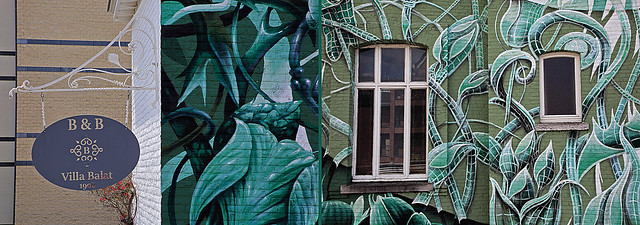La Villa Balat a été construite en 1906 à la demande d’Adolphine et Joséphine Balat, les nièces d’Alphonse Balat, architecte très apprécié du roi des Belges Léopold II et mentor du pape belge de l’Art Nouveau, Victor Horta. On lui doit notamment les Serres royales de Laeken et le Musée des Beaux-Arts de Bruxelles. Située en bord de Meuse, au pied de la nouvelle passerelle cyclo-piétonne « l’Enjambée », reliant Jambes à Namur, la Villa Balat offre une vue plongeante sur la Citadelle et le Parlement wallon. Elle fut rachetée en 2016 par les propriétaires actuels, Muriel et Bernard, qui lui redonnèrent son éclat d’antan.
L’histoire de cette fresque, c’est d’abord une rencontre entre Muriel et Démosthène Stellas, artiste namurois spécialisé dans la peinture murale et fondateur du collectif Drash, actif dans les domaines du son et de l’image. Fruit d’une longue maturation, le projet put bénéficier d’un subside communal. Il s’inscrit dans le parcours d’art urbain « L’Art dans la Ville », mis en place depuis 2014. Son but ? Favoriser l’accès à la culture pour tous par le biais du street art entre autres. La fresque de Démosthène s’ajoute à une série d’oeuvres, dont les sculptures d’Isaac Cordal et les Fourmis géantes de Nicolas Eres
Tout d’abord, la période artistique dans laquelle baignait Alphonse Balat fut le socle fondateur de la fresque. Les débuts de l’Art Nouveau ont marqué le discours de l’architecte: » Simplifiez, simplifiez encore, simplifiez toujours et quand vous aurez tout simplifié, vous n’aurez pas encore assez simplifié « , un lien évident avec l’architecture contemporaine de l’Enjambée. Ensuite, les « Essentielles » du photographe allemand Karl Blossfeldt, une série de variétés végétales en gros plan des années 30, inspirèrent l’esthétique. Pour finir, la palette des verts fut choisie pour des raisons techniques: la couche de fond utilisée par Démosthène est une peinture minérale naturelle où les teintes criantes n’existent pas et puis, le vert était un ton à la mode à la Belle Epoque. Quant aux raisons créatives, il suffit d’admirer la richesse de la végétation et les humeurs changeantes de notre belle Meuse pour le comprendre …
Villa Balat was built in 1906 at the request of Adolphine and Joséphine Balat, the nieces of Alphonse Balat, architect much appreciated by the King of the Belgians Leopold II and mentor of the Belgian pope of Art Nouveau, Victor Horta. We owe him in particular the Royal Greenhouses of Laeken and the Museum of Fine Arts in Brussels. Located on the banks of the Meuse, at the foot of the new cycle-pedestrian footbridge "l'Enjambée", linking Jambes to Namur, Villa Balat offers a bird's eye view of the Citadel and the Walloon Parliament. It was bought in 2016 by the current owners, Muriel and Bernard, who restored it to its former glory.
The story of this fresco is first of all a meeting between Muriel and Démosthène Stellas, an artist from Namur specializing in mural painting and founder of the Drash collective, active in the fields of sound and image. The result of a long maturation, the project was able to benefit from a municipal subsidy. It is part of the urban art course "Art in the City", set up since 2014. Its goal? Promote access to culture for all through street art among others. The Demosthenes fresco adds to a series of works, including the sculptures of Isaac Cordal and the Giant Ants of Nicolas Eres
First of all, the artistic period in which Alphonse Balat bathed was the founding base of the fresco. The beginnings of Art Nouveau marked the architect's speech: "Simplify, simplify again, always simplify and when you have simplified everything, you will not have simplified enough", a clear link with the contemporary architecture of the stride. Next, German photographer Karl Blossfeldt’s “Essentials,” a series of close-up plant varieties from the 1930s, inspired the aesthetic. Finally, the palette of greens was chosen for technical reasons: the base coat used by Demosthenes is a natural mineral paint where glaring colors do not exist and then, green was a fashionable tone during the Belle Epoque. As for the creative reasons, it is enough to admire the richness of the vegetation and the changing moods of our beautiful Meuse to understand it...
 new
new


